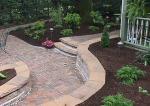

Please click above on this sponsor's banner to see their unique products.
Their sponsorship allows me to continue to provide my web site for you.
Thank you for your support and for visiting my web site.
Search engine visitors - click here to access entire "$ensible Home" web site


Please click above on this sponsor's banner to see their unique products.
Their sponsorship allows me to continue to provide my web site for you.
Thank you for your support and for visiting my web site.
Click here to see a descriptive illustration showing several designs of paver patio patterns.
Dear Jim: What do you think of building a decorative patio and walkway, with gecko-style concrete pavers, on the south side of my house to absorb the sun's heat? What construction options do I have for this? - Rick T.

A: First of all, your concept of laying a concrete (high thermal mass) paver patio on the south side of your house is excellent. The concrete will absorb some of the sun's heat during the day and reflect some of it up toward your house for greater heat gain during the winter.
At night, the stored heat will slowly radiate upward to create a warm thermal buffer area against your house. This reduces the rate of indoor heat loss through the walls and windows and makes you more comfortable.
During the summer, with the sun's position higher in the sky, the roof overhang or a small awning will shade the concrete from the sun's direct rays. With summer breezes being typically from the southwest, any warm air created by the sun's indirect rays on the patio is blown away.
There are many options and do-it-yourself products for building a unique-looking, attractive concrete patio or walkway. To create the gecko design that you referred to, purchase reusable plastic forms to make your own pavers. The forms create the interlocking pavers and unique surface textures.
For a country stone pattern, place a different type of reusable plastic form on the ground. Mix the concrete and shovel it into the form. Tap it down, smooth the surface with a trowel and lift out the plastic form. This leaves deep grooves in the concrete for the appearance of individual stones.
Place the same form down adjacent to the completed section, shovel in more concrete and repeat this process until the walkway or patio is completed. Forms for various patterns are available as are colorants for the concrete.
If you prefer to buy finished paver bricks locally, place a plastic paver-laying guide tray on the ground first. This levels the pavers and positions them for perfect spacing. Guides are available for various sizes of pavers.
Use an edging kit for a crisp, professional-looking edge. Several designs use flexible, tough, black plastic with built-in support stakes for perfect, neat curves. Another edging method uses plastic bricks with low-voltage wiring inside. Place special lighted bricks periodically along the edge.
Another efficient and simple patio option is colorful gravel. You can install large plastic forms consisting of one-inch-high tubes connected by webs. This is placed on the ground and then covered with gravel. It is so strong, that you can park a car on it and the gravel stays in place. Use SaverSystems paver treatment products to keep new patio in prime condition.
Instant Download Update Bulletin No. 715 - buyer's guide of 13 manufacturers of unique paving products, do-it-yourself molds, low-voltage lights built in bricks, paver layout guides, patio edging systems, list (by state) of 55 local interlocking concrete paver manufacturers, illustrations of several patterns and patio building instructions showing several diagrams.
Dear Jim: We have one faucet in the bathroom that is very noisy when I turn on the water. It does not leak that I can see. What causes it to be so noisy and what can I do to fix it? - Sylvia R.
A: There can be several causes of a noisy faucet, but the most likely one is a faulty washer or seat. First try replacing the washer. If that does not help much, replace the seat that it seals against.
When a faucet is noisy from a faulty washer, it may already leak slightly or will soon leak. Even a small, slow water drip can cause higher water and energy bills if it is on the hot water side.